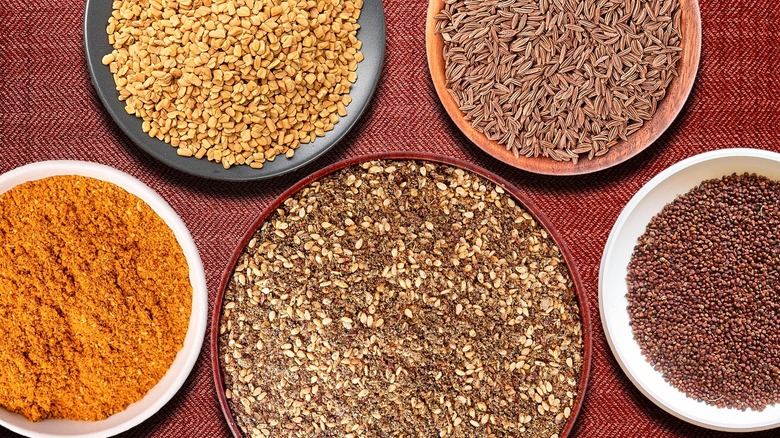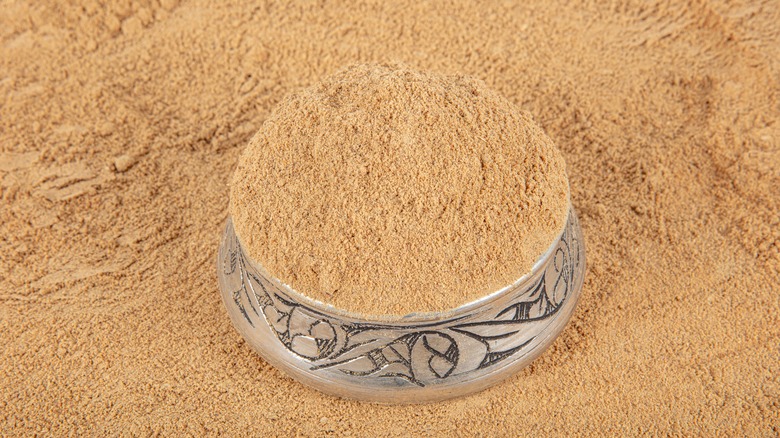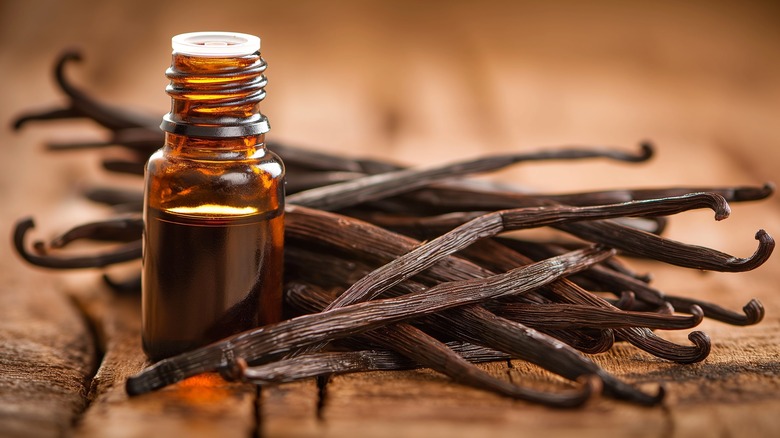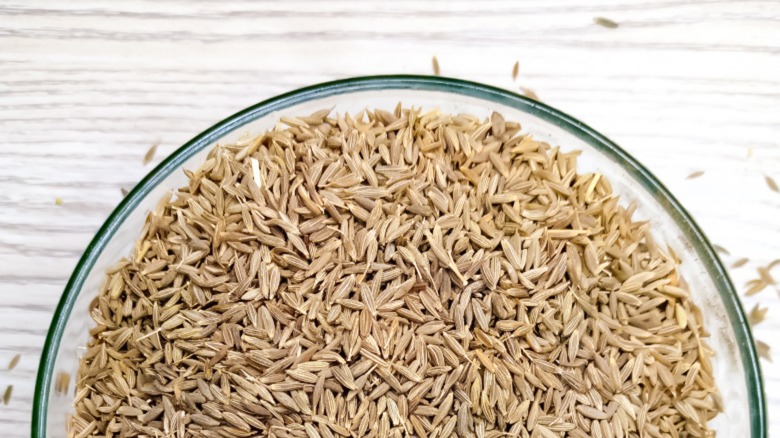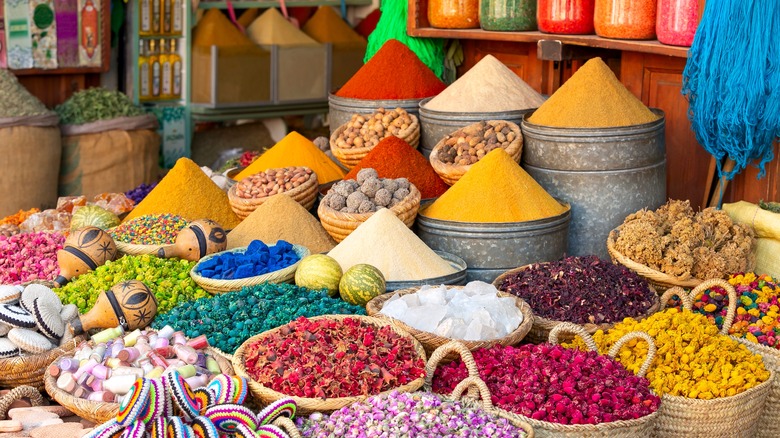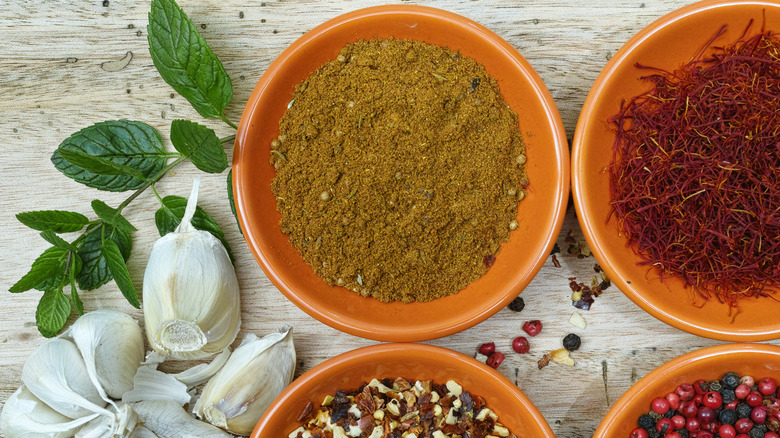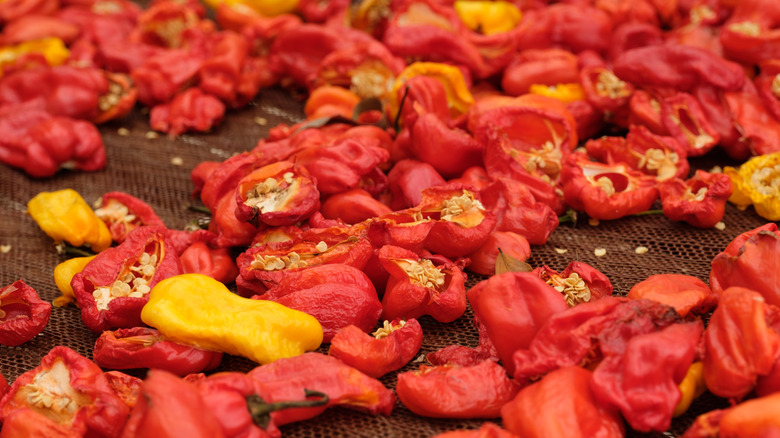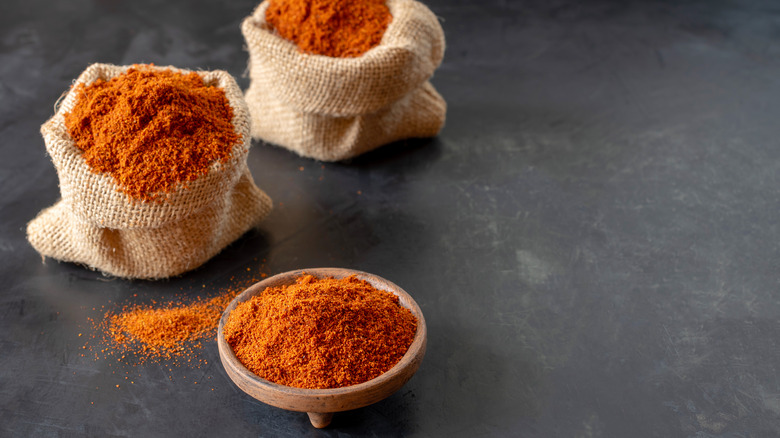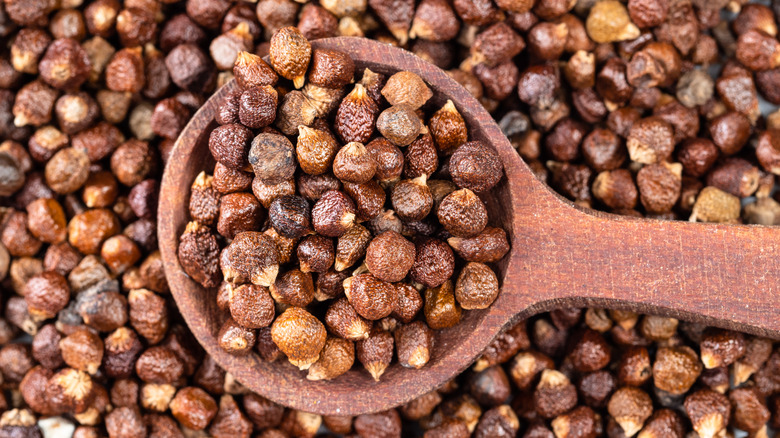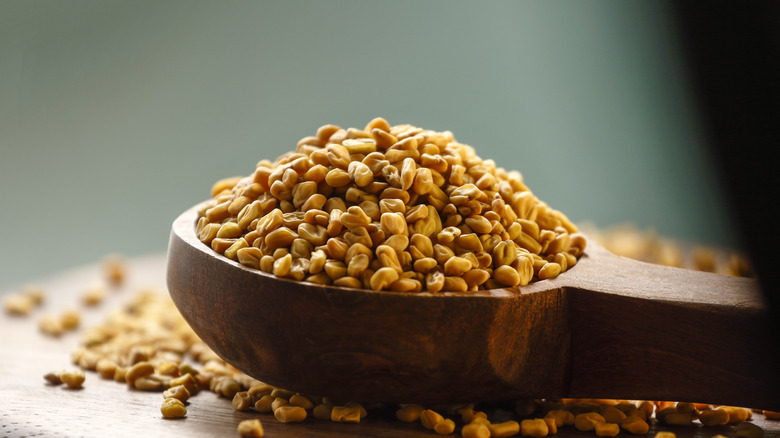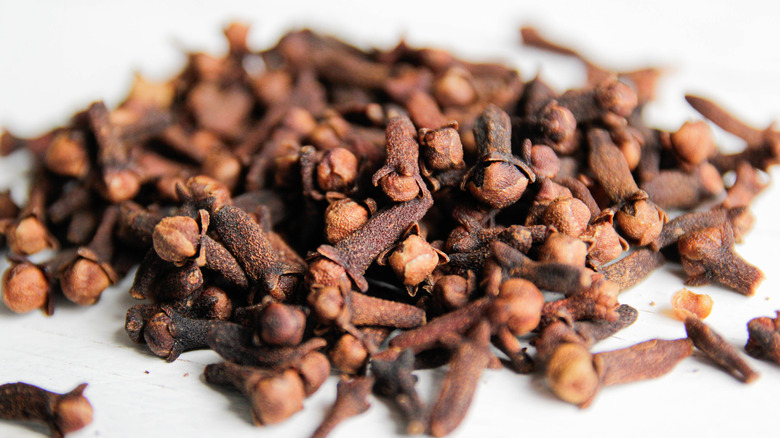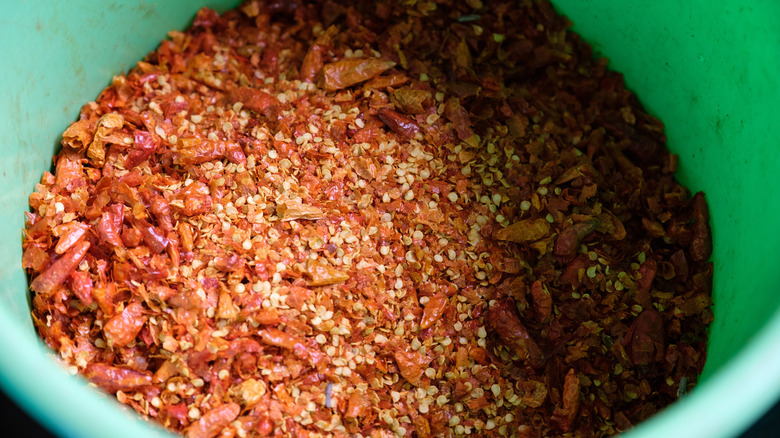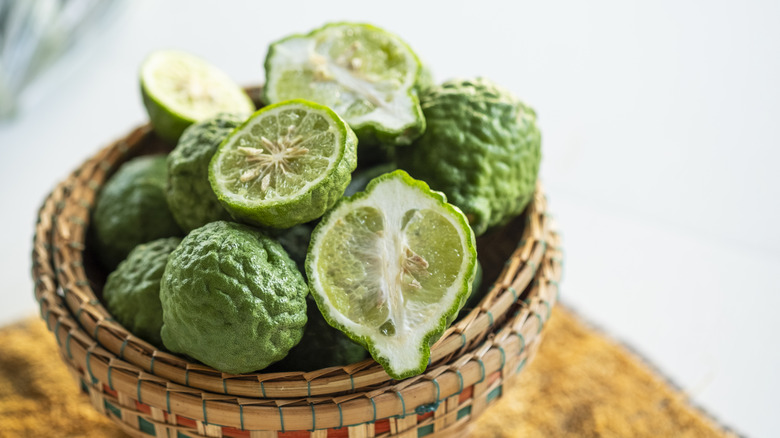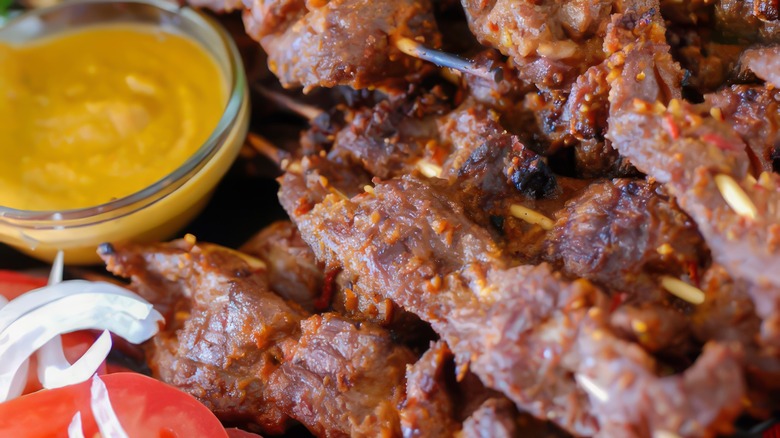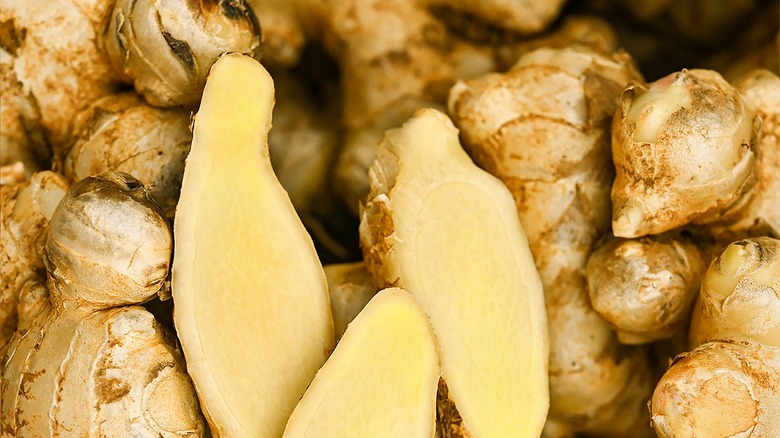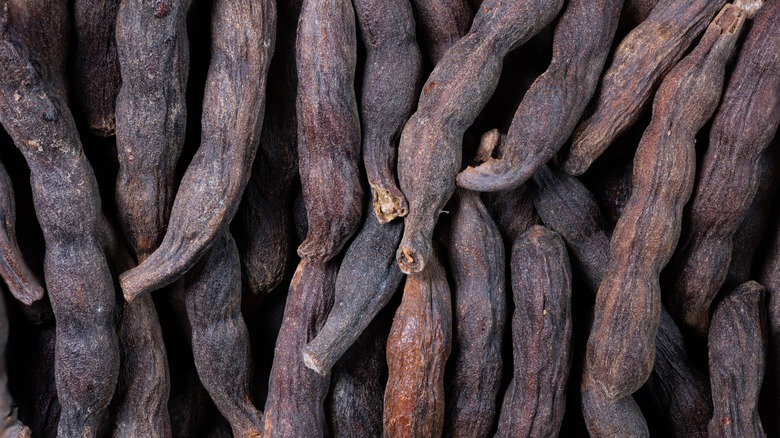15 African Seasonings To Spice Up Your Next Dish
If you've ever been to Africa and tasted the cuisine, then you already know how incredibly flavorful it can be. Of course, the cuisine varies greatly depending on the country, region, and culture you're cooking and dining with, but there are some continent-wide consistencies. One of those consistencies is the incredible amount of spices used in African cuisine. As a cultural anthropology major with a focus on African studies and food culture, I've always found interest in what makes a spice notably linked to a certain cuisine. As we know, spices have been traded all over the globe since cultures began intermingling. I talked with executive head chef Mohamed Yakat Ali of the five-star Kenyan restaurant Jiko, and together, we discussed the most notable African seasonings to spice up your next dish.
Our spice cabinets may be a bit more limited in the United States, depending on our expertise and culinary range. In Africa, both spices and spice mixes are used heavily and frequently. It's possible you have never heard of some of the spice mixes used frequently in Africa or even the spices themselves. Not all of the plants bearing these spices were originally grown on the continent. However, through the melding of cultures, expansion of trade routes, and colonization, these plants have made their way onto the continent and added to Africa's incredible cuisine.
Za'atar
You may have enjoyed a za'atar seasoning blend incorporated into Middle Eastern cuisine at a restaurant or even bought a jar to keep in your spice pantry, as it's become increasingly popular in the United States. Za'atar is a mix of complex spices and herbs, including thyme, marjoram, oregano, sumac, and cumin. The addition of ground sesame seeds makes the mix unique. The quantities and spices can vary, omitting some spices and adding others like coriander to the mix. Chef Mohamed Yakat describes its purpose: "Za'atar is used to enhance multiple dishes with its tangy, citrus, and nutty flavor." It's wildly popular in North African cuisine, and za'atar has many uses.
Because of the toasted sesame seeds, the spice mix melts in your mouth and has a nutty and rich mouthfeel. Coupled with the grassy and citrus notes from the oregano, it has several layers of flavor that come together. You can buy za'atar spice mix at the store or make your own homemade za'atar spice blend.
Madagascar vanilla
Now, I'm sure when perusing the baking aisle for vanilla you've noticed the range of options to choose from. Some are off-the-charts pricey, while other bottles of vanilla are, well, still quite expensive. But who can resist this intensely aromatic, rich, and heavenly flavoring? It is the garlic of the baking world — aka, you can never add too much to your recipe. As it turns out, much of the world's vanilla comes from Africa, specifically Madagascar. However, it did not originate there but instead was brought over from Mexico in the 1800s.
Although vanilla is such a huge crop on the island, much of it is exported as it is primarily a cash crop. However, it's still popular in baking within the continent and is a huge benefit to the economy. So, although vanilla isn't a predominant flavor used in African cuisine, it is still present and is surely considered African through and through. In fact, if you check your bottle of vanilla sitting front and center in your cupboard, I bet it is likely from Madagascar.
Cumin
North African cuisine has a beautiful mix of Middle Eastern, Mediterranean, and Indian influences. Cumin was originally cultivated in Iran and the Mediterranean, and it's one of those spices that is used across the world. It's especially popular in North Africa. But it's not for everyone. Cumin is intense, and many describe it as earthy and aromatic. Its pungent flavor is savory and can even be a bit nutty. It has similar notes to ground coriander or caraway and it's often an ingredient in spice mixes. Contrary to popular belief, cumin isn't spicy.
Chef Mohamed Yakat Ali uses cumin in the most spice-heavy dish on the menu. "At Jiko, kondoo mchuzi is a lamb stew combined with sukuma wiki and ugali, all baked in puff pastry and prepared with a variety of spices." He continues, "The recipe involves smokey African curry spice; a blend of fennel seeds, cumin seeds, coriander, turmeric, paprika, ginger, and ground selim pepper. To this blend, we add akabanga chili oil from Rwanda to round out the flavor and balance the savory and umami notes with a spicy kick."
Tan-tan
People come from all over the world to buy spices at Morocco's markets. Those heaping peaks of vibrant yellow, sunset orange, and toasty red can make for much more than just a beautiful picture. Because of its location, Morocco is a hub for spice trading across continents, and the cuisine reflects it. Tan-tan is a mixture of spices from around the world, made and used heavily in Morocco.
Tan tan is sweet, savory, spicy, and loaded with earthy depth. The seasoning contains savory spices like black cardamom, cumin, salt, parsley, coriander, and turmeric. The sweeter notes are brought on by paprika, fenugreek, anise, and sugar. Spicy undertones include Ceylon and Saigon cinnamon, black pepper, mustard powder, cayenne, and mace. For an easy application of tan-tan, consider turning to grilled meat. Rub meat down with tan-tan and let the balanced notes bring out everything we love about roasted meat. Try it on roasted vegetables, or even use it to top sweet potatoes or squash.
Ras el hanout
Ras el hanout spice mix truly is the cream of the crop, as its name translates to "head of the shop" in Arabic. Its popularity in the Middle East and North and West Africa is unmatched, as it can be used in most savory applications. Ras el hanout spice blend is especially adored when used to boost the richness of meat dishes.
This ingredient is essential to Moroccan cooking. However, for someone new to the African or Arabic food scene, the spice mix itself may be rather confusing. It's not always made the same way, although there are many spices that are commonly used in combination to make ras el hanout. Depending on who made it, what region they are in, and what quality spices are available, the recipe varies and can contain up to 40 ingredients. Moroccan ras en hangout often includes cumin and fenugreek. Some of these spices are rare, difficult to source, or expensive. The mix is consistently savory with sweet undertones from spices like paprika, cinnamon, or fenugreek.
Chiles
Almost every culture uses chiles because most people love a little kick of heat in their food. And while that "little kick" is enough for some, others prefer smoke to come out of their ears. Whatever the vibe, African chiles have the potential to be almost lethally hot. In fact, there is a Rwandan chili oil called akabanga that is so spicy it's sold in dropper bottles, because one tiny drop can make all the difference.
Mohamad Yakat Ali lists the spices he frequently uses to add heat to his dishes: "chili powder, berbere, mitmita, cayenne, alligator pepper, and akabanga." Jalapeño, bird's eye, and African ghost peppers are some of the more common heat-producing chiles used in African cooking, but the list is extensive. Most peppers can be found dried and ground, bottled as a sauce, or fresh and ready to be chopped. African peppers make their way into many spice mixes, including berbere, and sometimes ras el hanout. You can order African chili powder online and may even be able to find it locally in a specialty market.
Berbere
Perhaps one of the most beloved Ethiopian seasonings, berbere, has endless applications and is adored by African chefs. Mohamad Yakat Ali notes that berbere is one of the three most popular seasonings in Africa, the other two being curry powder and suya. Berbere African spice blend is fairly complex. It's a mix of coriander, fenugreek, black pepper, cardamom, cloves, onion flakes or powder, hot chiles, paprika, cinnamon, ginger, nutmeg, and salt.
This spice mix is warming, spicy, and pungent. The cinnamon, ginger, and chiles create heat, while the fenugreek and cardamom bring sweetness and floral notes. This mix can be used on meat but can also help bring depth and warmth to a stew or sauce, especially one with a meaty tomato base. Marcus Samuelsson's berbere recipe is simple and can be used on anything from grilled fruit to ricotta toast. Spice up your life the Ethiopian way with berbere.
Grains of paradise
Grains of paradise, also referred to as "African pepper," are seeds native to North and West Africa that are used as spices to flavor everything from food to wine. They are described as an improved spiced peppercorn that has both nutty and citrus undertones. They are absolutely heavenly, as their name would suggest. Grains of paradise were first discovered in West Africa, where it is grown mostly as a cash crop, but has since been cultivated across continents.
Although grains of paradise look quite a bit like peppercorns, they are actually part of the ginger family. Much like those two spices, grains of paradise can be used in both a sweet and savory capacity, capitalizing on the earthy undertones of savory cuisine. There are endless things you need to know about grains of paradise, but the most important is that their versatility and desirable flavoring put them at the top of the charts for African seasonings to spice up your next dish.
Fenugreek
The herb fenugreek is famous in the breastfeeding world, as it promotes milk production during lactation. However, it's also a popular spice that can be enjoyed by all. Although it's not native to the continent of Africa, it did make its way down from the Mediterranean and over from West Asia. And while it works medicinal magic beyond lactation, it's most commonly used for its irresistible flavor. It's a clove-like herb, which makes it sweet and aromatic. The seeds have the aroma of maple syrup, although the flavor is slightly bitter and botanical when eaten on its own.
It's often used in a savory capacity despite its sweet scent. Africans often use fenugreek to finish dishes, and you can find it as an ingredient in anything from West African peanut stew to a basic goat or vegetable curry. In fact, fenugreek is often used beside curry powder, which also has hints of sweetness and is a popular African seasoning.
Dadoa amba or pepre
Dadoa amba, also known as pepre or cloves, is one of those truly intense spices that can be used in both a sweet and savory capacity. Recently, I tried the East African grain teff for the first time and made it into a porridge using dates, honey, and cloves as the only seasonings. The flavor was intense and unique because of the aromatic spice. Often, cloves are used alongside cinnamon, nutmeg, and allspice.
Cooking with cloves is particularly popular in Ghana. They are a necessity in some of the beloved regional dishes like kelewele, jollof rice, and groundnut soup. The Ghanaian drink sobolo, which goes by a myriad of other names, uses cloves, along with hibiscus, ginger, and other powerful flavors. Cloves add warmth to the refreshing drink, creating a duality that offers contrast and range. Dodoa amba is often paired with red meats, as well as mixed into savory seasonings for tomato-based stews and roasted vegetables.
Peri peri chili powder
Although chili powder had its own section in our list of African seasonings to spice up your next dish, peri peri chili powder deserves its very own acknowledgment. First discovered in Mozambique and South Africa, the African bird's eye chili pepper has gained popularity around the world. When Portuguese explorers discovered the pepper, they made it into the ever-so-famous peri peri sauce by mixing it with olive oil and other herbs. You may find it spelled both as "peri peri" and "piri piri" which simply translates to "pepper pepper."
What makes piri piri sauce unique is its bold flavor, coupled with the intensity of heat brought on by the peppers. It can be described as "firey" as these peppers carry around 150,000 Scoville units, making the powder entirely desirable for those who love to shed a few tears when they eat. Not only did these peppers originate in Africa, but they aren't just a cash crop, as many cultures across the continent love to amp up the heat in their cuisine with peri peri.
Combava
Madagascar may be famous for its vanilla, but there is another ingredient grown there that should get some recognition. Combava goes by a few names and is a type of lime that is often made into powdered seasoning. This seasoning is made by drying the limes and grinding them down into a fine powder that can be used in cooking. These limes are unlike the ones you might find in your local grocery store. They are smaller, lumpier, and differ in flavor.
Combava limes and their powder can be described as including spicy notes best compared to ginger. There are undertones of coriander which give it a floral kick, as well as some of the sweeter citrus flavors of lemon. Combava can be used to excite the taste buds in both savory dishes and desserts. It's tangy, bitter, and sweet all in one, and can be used to give any dish a kick. Consider using it in a seafood seasoning or on fresh or grilled fruit.
Suya
Although most spice mixes consist of (you guessed it) spices, there are some that break that boundary to include nuts and seeds. You may be familiar with the sesame seed-ridden za'atar seasoning, but there is another African seasoning to take note of. Suya, a Nigerian seasoning mix, is made with ground peanuts, which give it a dense and fatty mouthfeel. The nutty flavoring of the peanut helps to balance the intensity of the other ingredients, which are typically garlic, ginger, and cloves.
Suya spice mix is most popularly used in Nigerian street food, also called suya. The street food is made with strips of meat cooked over an open flame and loaded with the seasoning suya. The combination of meat and peanuts makes for a dense, meaty, and chewy dish that creates a stick-to-your-ribs effect. Chef Mohamed Yakat Ali notes that suya is one of the top three most popular African seasonings, especially beloved in West African cuisine.
Ginger
Ginger is one of those spies that truly does it all. It's a superfood that is incredible for the function of your entire body. You may have even used it to calm a stomach ache. It's spicy and sweet and can be used in just about any application, from flavoring ice cream to seasoning meat. Chef Mohamed Yakat Ali explains its popular application in African cuisine: "Ginger is commonly found in recipes throughout Kenya; it is a key ingredient for barbecued beef skewers (mshikaki), chicken (kuku paka), and fish (Swahili curry)." It's often used in meat-based recipes but is more popularly used in baking in American cuisine.
Although ginger is a root, it can be dried and ground down into a powder. It's an ancient spice that took root over 4,000 years ago. The oldest reported use of ginger was in Asia, but it quickly made its way around the world and became a staple spice in Africa.
Selim pepper
Also known as grains of selim, selim pepper is a musky pepper found along the West African coastline. While the peppercorn you may find at your local market may taste spicy with a hint of sweetness, selim pepper has additional layers of flavors. The tree's fruit is loaded with subtle notes of tropical flavors like coconut along with nutty and woody nutmeg-like flavors. Its spiciness is ginger-like and it has a eucalyptus-like freshness to it. Often, these ground peppercorns are found in suya and other popular African spice blends.
While pepper is typically reserved for food, selim pepper is used in café touba, a Senegalese coffee drink that includes the peppers along with ground cloves. While it's a popular spice to use in African cuisine, selim pepper is also popular in Europe and is exported as a cash crop. It's also known to be added to desserts but is mostly used in savory dishes.
